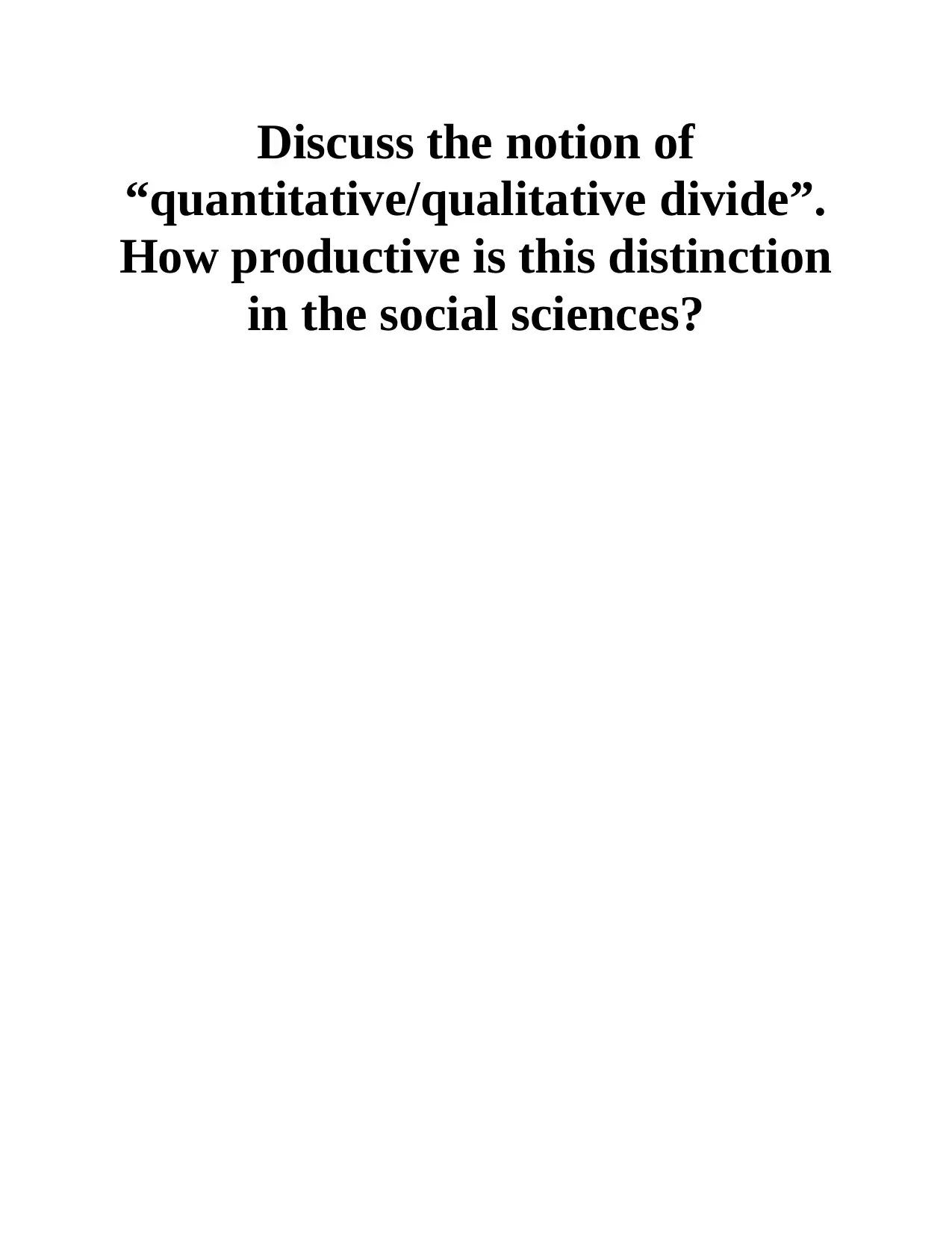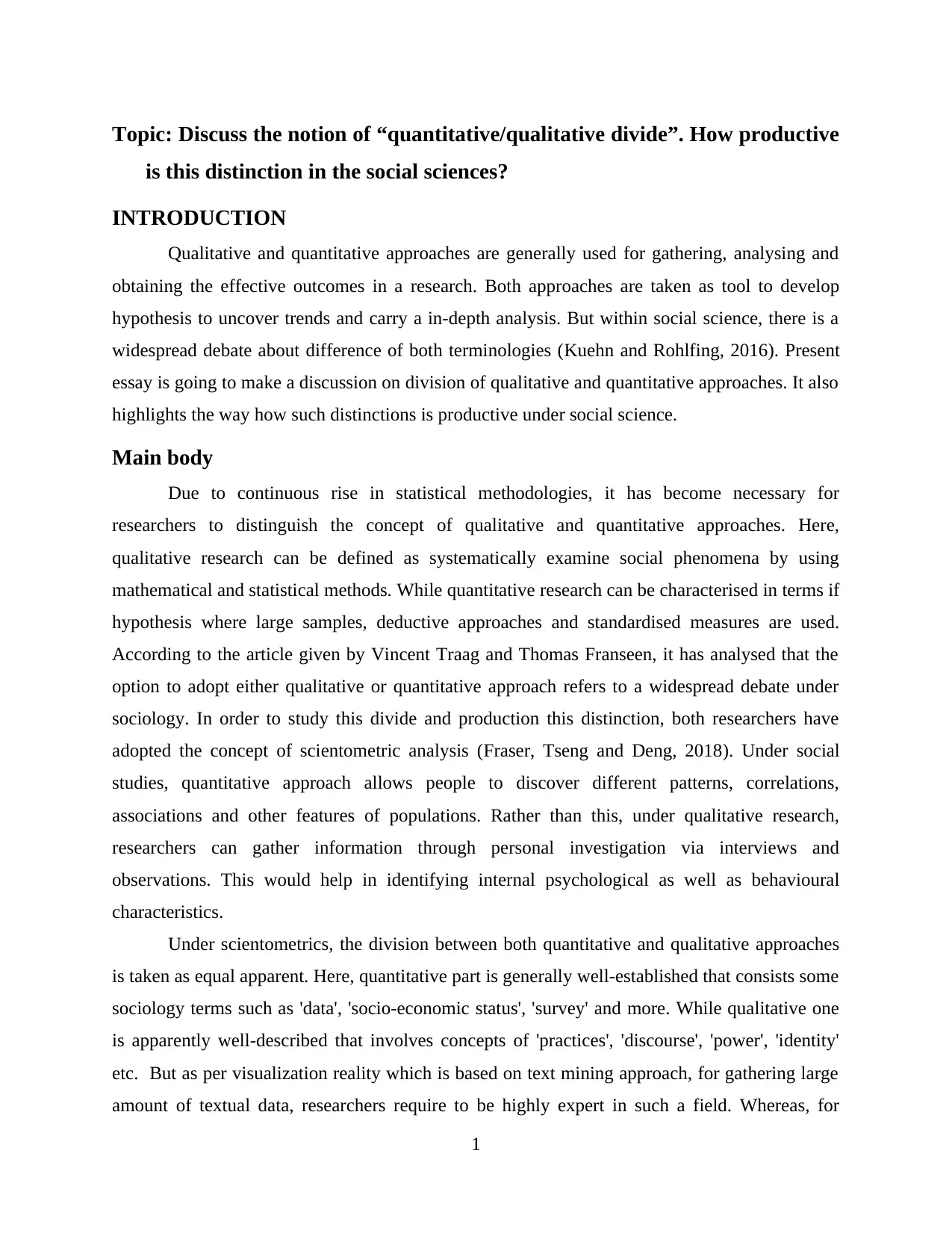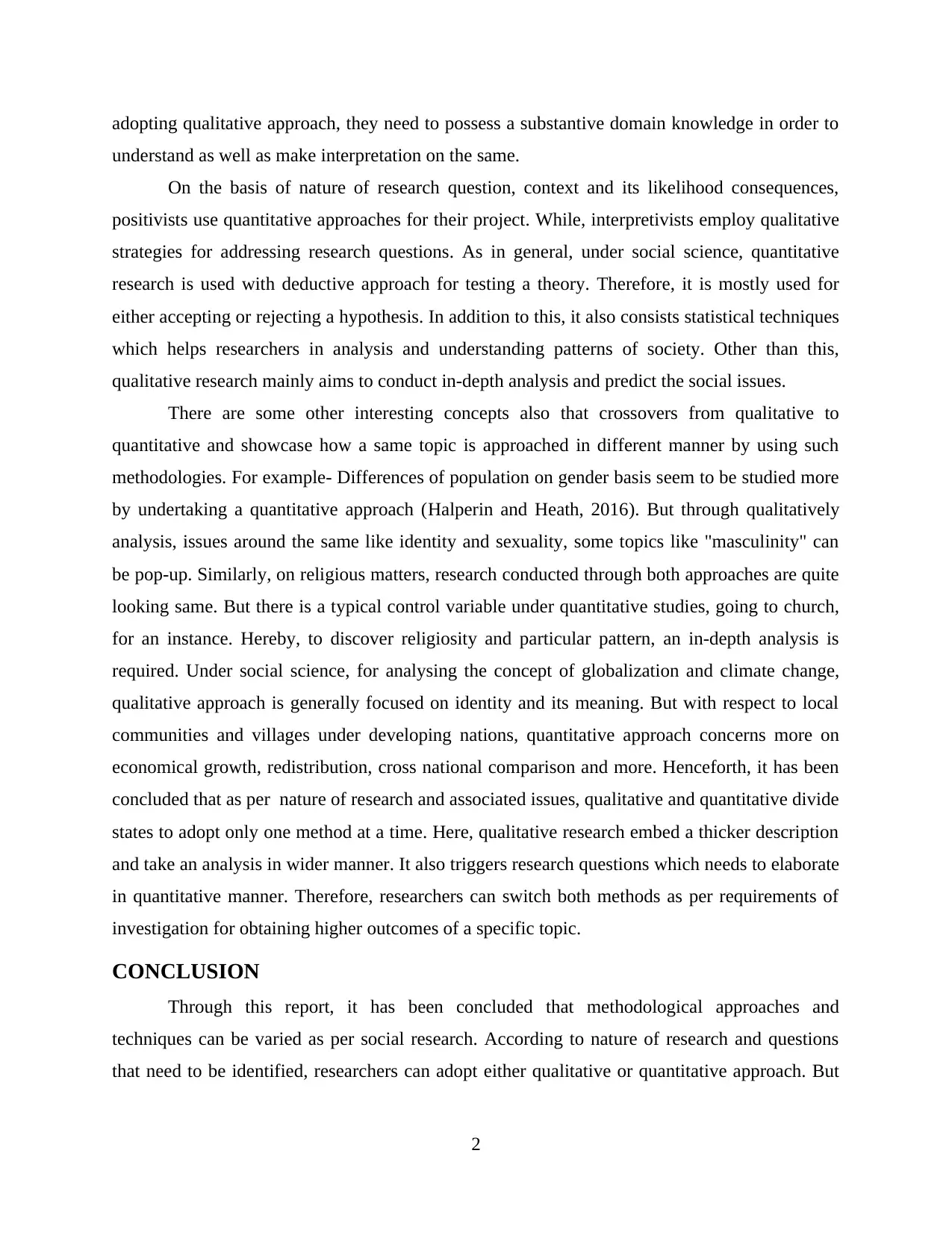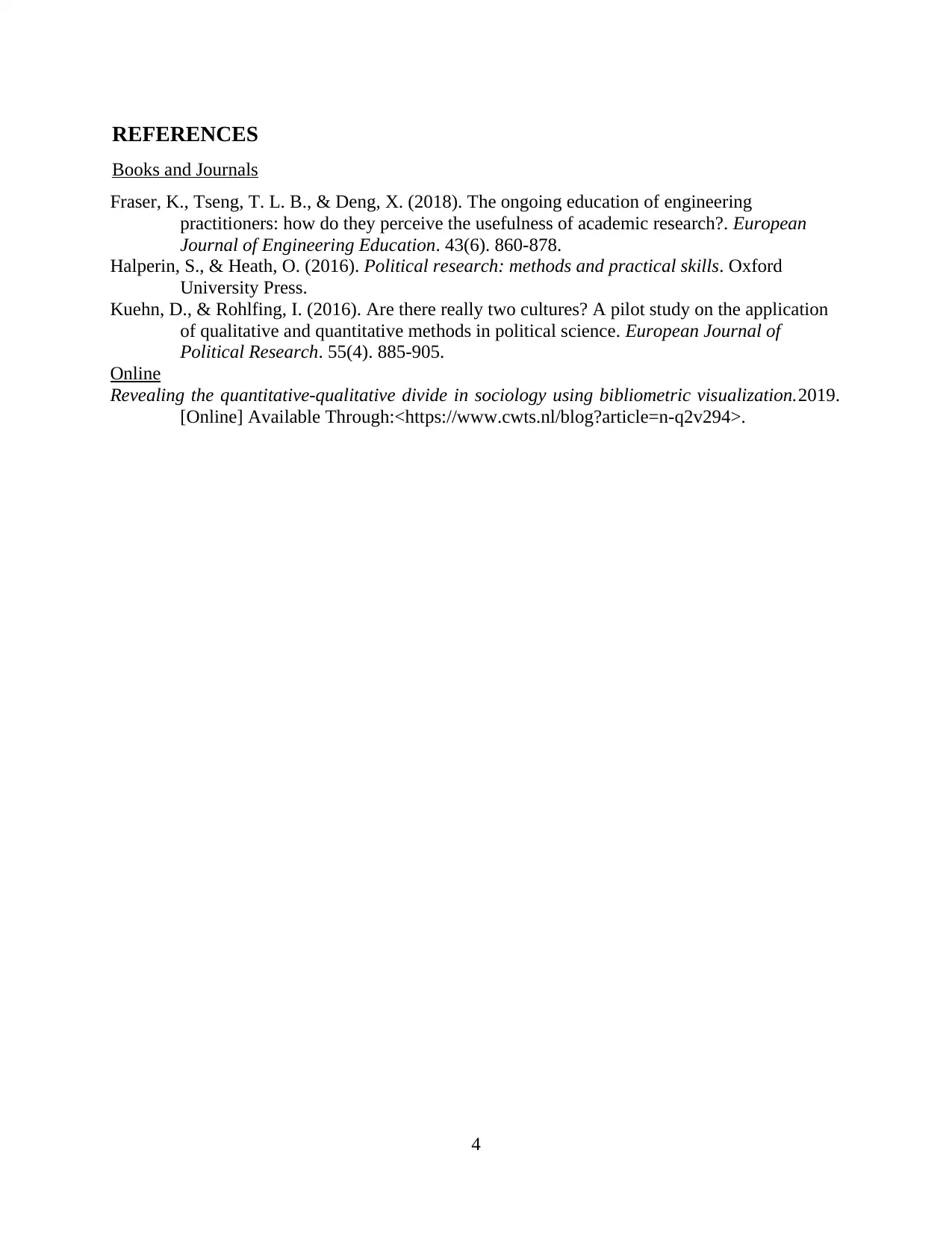Productivity of Quantitative/Qualitative Distinction in Social Science
VerifiedAdded on 2020/12/10
|7
|1062
|409
Essay
AI Summary
This essay critically examines the ongoing debate surrounding the quantitative and qualitative divide in social sciences. It begins by defining both qualitative and quantitative research approaches, highlighting their distinct methodologies, data collection techniques, and analytical strategies. The essay then delves into the arguments for and against this division, exploring how researchers utilize both approaches to uncover patterns, correlations, and in-depth insights into social phenomena. It discusses how quantitative methods, often associated with statistical analysis and deductive reasoning, are used to test hypotheses and identify trends, while qualitative methods, involving interviews and observations, provide rich, contextualized understandings of social issues. The essay further explores how both approaches can be used to study the same topic in different ways, providing a more complete analysis. Finally, the essay concludes that the choice of method depends on the research question and the desired outcomes, and that the integration of both approaches can provide a more comprehensive understanding of social issues.

Discuss the notion of
“quantitative/qualitative divide”.
How productive is this distinction
in the social sciences?
“quantitative/qualitative divide”.
How productive is this distinction
in the social sciences?
Paraphrase This Document
Need a fresh take? Get an instant paraphrase of this document with our AI Paraphraser

Table of Contents
Topic: Discuss the notion of “quantitative/qualitative divide”. How productive is this distinction
in the social sciences?......................................................................................................................1
INTRODUCTION...........................................................................................................................1
Main body........................................................................................................................................1
CONCLUSION................................................................................................................................2
REFERENCES................................................................................................................................4
Topic: Discuss the notion of “quantitative/qualitative divide”. How productive is this distinction
in the social sciences?......................................................................................................................1
INTRODUCTION...........................................................................................................................1
Main body........................................................................................................................................1
CONCLUSION................................................................................................................................2
REFERENCES................................................................................................................................4

⊘ This is a preview!⊘
Do you want full access?
Subscribe today to unlock all pages.

Trusted by 1+ million students worldwide

Topic: Discuss the notion of “quantitative/qualitative divide”. How productive
is this distinction in the social sciences?
INTRODUCTION
Qualitative and quantitative approaches are generally used for gathering, analysing and
obtaining the effective outcomes in a research. Both approaches are taken as tool to develop
hypothesis to uncover trends and carry a in-depth analysis. But within social science, there is a
widespread debate about difference of both terminologies (Kuehn and Rohlfing, 2016). Present
essay is going to make a discussion on division of qualitative and quantitative approaches. It also
highlights the way how such distinctions is productive under social science.
Main body
Due to continuous rise in statistical methodologies, it has become necessary for
researchers to distinguish the concept of qualitative and quantitative approaches. Here,
qualitative research can be defined as systematically examine social phenomena by using
mathematical and statistical methods. While quantitative research can be characterised in terms if
hypothesis where large samples, deductive approaches and standardised measures are used.
According to the article given by Vincent Traag and Thomas Franseen, it has analysed that the
option to adopt either qualitative or quantitative approach refers to a widespread debate under
sociology. In order to study this divide and production this distinction, both researchers have
adopted the concept of scientometric analysis (Fraser, Tseng and Deng, 2018). Under social
studies, quantitative approach allows people to discover different patterns, correlations,
associations and other features of populations. Rather than this, under qualitative research,
researchers can gather information through personal investigation via interviews and
observations. This would help in identifying internal psychological as well as behavioural
characteristics.
Under scientometrics, the division between both quantitative and qualitative approaches
is taken as equal apparent. Here, quantitative part is generally well-established that consists some
sociology terms such as 'data', 'socio-economic status', 'survey' and more. While qualitative one
is apparently well-described that involves concepts of 'practices', 'discourse', 'power', 'identity'
etc. But as per visualization reality which is based on text mining approach, for gathering large
amount of textual data, researchers require to be highly expert in such a field. Whereas, for
1
is this distinction in the social sciences?
INTRODUCTION
Qualitative and quantitative approaches are generally used for gathering, analysing and
obtaining the effective outcomes in a research. Both approaches are taken as tool to develop
hypothesis to uncover trends and carry a in-depth analysis. But within social science, there is a
widespread debate about difference of both terminologies (Kuehn and Rohlfing, 2016). Present
essay is going to make a discussion on division of qualitative and quantitative approaches. It also
highlights the way how such distinctions is productive under social science.
Main body
Due to continuous rise in statistical methodologies, it has become necessary for
researchers to distinguish the concept of qualitative and quantitative approaches. Here,
qualitative research can be defined as systematically examine social phenomena by using
mathematical and statistical methods. While quantitative research can be characterised in terms if
hypothesis where large samples, deductive approaches and standardised measures are used.
According to the article given by Vincent Traag and Thomas Franseen, it has analysed that the
option to adopt either qualitative or quantitative approach refers to a widespread debate under
sociology. In order to study this divide and production this distinction, both researchers have
adopted the concept of scientometric analysis (Fraser, Tseng and Deng, 2018). Under social
studies, quantitative approach allows people to discover different patterns, correlations,
associations and other features of populations. Rather than this, under qualitative research,
researchers can gather information through personal investigation via interviews and
observations. This would help in identifying internal psychological as well as behavioural
characteristics.
Under scientometrics, the division between both quantitative and qualitative approaches
is taken as equal apparent. Here, quantitative part is generally well-established that consists some
sociology terms such as 'data', 'socio-economic status', 'survey' and more. While qualitative one
is apparently well-described that involves concepts of 'practices', 'discourse', 'power', 'identity'
etc. But as per visualization reality which is based on text mining approach, for gathering large
amount of textual data, researchers require to be highly expert in such a field. Whereas, for
1
Paraphrase This Document
Need a fresh take? Get an instant paraphrase of this document with our AI Paraphraser

adopting qualitative approach, they need to possess a substantive domain knowledge in order to
understand as well as make interpretation on the same.
On the basis of nature of research question, context and its likelihood consequences,
positivists use quantitative approaches for their project. While, interpretivists employ qualitative
strategies for addressing research questions. As in general, under social science, quantitative
research is used with deductive approach for testing a theory. Therefore, it is mostly used for
either accepting or rejecting a hypothesis. In addition to this, it also consists statistical techniques
which helps researchers in analysis and understanding patterns of society. Other than this,
qualitative research mainly aims to conduct in-depth analysis and predict the social issues.
There are some other interesting concepts also that crossovers from qualitative to
quantitative and showcase how a same topic is approached in different manner by using such
methodologies. For example- Differences of population on gender basis seem to be studied more
by undertaking a quantitative approach (Halperin and Heath, 2016). But through qualitatively
analysis, issues around the same like identity and sexuality, some topics like "masculinity" can
be pop-up. Similarly, on religious matters, research conducted through both approaches are quite
looking same. But there is a typical control variable under quantitative studies, going to church,
for an instance. Hereby, to discover religiosity and particular pattern, an in-depth analysis is
required. Under social science, for analysing the concept of globalization and climate change,
qualitative approach is generally focused on identity and its meaning. But with respect to local
communities and villages under developing nations, quantitative approach concerns more on
economical growth, redistribution, cross national comparison and more. Henceforth, it has been
concluded that as per nature of research and associated issues, qualitative and quantitative divide
states to adopt only one method at a time. Here, qualitative research embed a thicker description
and take an analysis in wider manner. It also triggers research questions which needs to elaborate
in quantitative manner. Therefore, researchers can switch both methods as per requirements of
investigation for obtaining higher outcomes of a specific topic.
CONCLUSION
Through this report, it has been concluded that methodological approaches and
techniques can be varied as per social research. According to nature of research and questions
that need to be identified, researchers can adopt either qualitative or quantitative approach. But
2
understand as well as make interpretation on the same.
On the basis of nature of research question, context and its likelihood consequences,
positivists use quantitative approaches for their project. While, interpretivists employ qualitative
strategies for addressing research questions. As in general, under social science, quantitative
research is used with deductive approach for testing a theory. Therefore, it is mostly used for
either accepting or rejecting a hypothesis. In addition to this, it also consists statistical techniques
which helps researchers in analysis and understanding patterns of society. Other than this,
qualitative research mainly aims to conduct in-depth analysis and predict the social issues.
There are some other interesting concepts also that crossovers from qualitative to
quantitative and showcase how a same topic is approached in different manner by using such
methodologies. For example- Differences of population on gender basis seem to be studied more
by undertaking a quantitative approach (Halperin and Heath, 2016). But through qualitatively
analysis, issues around the same like identity and sexuality, some topics like "masculinity" can
be pop-up. Similarly, on religious matters, research conducted through both approaches are quite
looking same. But there is a typical control variable under quantitative studies, going to church,
for an instance. Hereby, to discover religiosity and particular pattern, an in-depth analysis is
required. Under social science, for analysing the concept of globalization and climate change,
qualitative approach is generally focused on identity and its meaning. But with respect to local
communities and villages under developing nations, quantitative approach concerns more on
economical growth, redistribution, cross national comparison and more. Henceforth, it has been
concluded that as per nature of research and associated issues, qualitative and quantitative divide
states to adopt only one method at a time. Here, qualitative research embed a thicker description
and take an analysis in wider manner. It also triggers research questions which needs to elaborate
in quantitative manner. Therefore, researchers can switch both methods as per requirements of
investigation for obtaining higher outcomes of a specific topic.
CONCLUSION
Through this report, it has been concluded that methodological approaches and
techniques can be varied as per social research. According to nature of research and questions
that need to be identified, researchers can adopt either qualitative or quantitative approach. But
2

before choosing any appropriate tool is crucial for researchers, to identify the purpose of
conducting an investigation.
3
conducting an investigation.
3
⊘ This is a preview!⊘
Do you want full access?
Subscribe today to unlock all pages.

Trusted by 1+ million students worldwide

REFERENCES
Books and Journals
Fraser, K., Tseng, T. L. B., & Deng, X. (2018). The ongoing education of engineering
practitioners: how do they perceive the usefulness of academic research?. European
Journal of Engineering Education. 43(6). 860-878.
Halperin, S., & Heath, O. (2016). Political research: methods and practical skills. Oxford
University Press.
Kuehn, D., & Rohlfing, I. (2016). Are there really two cultures? A pilot study on the application
of qualitative and quantitative methods in political science. European Journal of
Political Research. 55(4). 885-905.
Online
Revealing the quantitative-qualitative divide in sociology using bibliometric visualization.2019.
[Online] Available Through:<https://www.cwts.nl/blog?article=n-q2v294>.
4
Books and Journals
Fraser, K., Tseng, T. L. B., & Deng, X. (2018). The ongoing education of engineering
practitioners: how do they perceive the usefulness of academic research?. European
Journal of Engineering Education. 43(6). 860-878.
Halperin, S., & Heath, O. (2016). Political research: methods and practical skills. Oxford
University Press.
Kuehn, D., & Rohlfing, I. (2016). Are there really two cultures? A pilot study on the application
of qualitative and quantitative methods in political science. European Journal of
Political Research. 55(4). 885-905.
Online
Revealing the quantitative-qualitative divide in sociology using bibliometric visualization.2019.
[Online] Available Through:<https://www.cwts.nl/blog?article=n-q2v294>.
4
1 out of 7
Related Documents
Your All-in-One AI-Powered Toolkit for Academic Success.
+13062052269
info@desklib.com
Available 24*7 on WhatsApp / Email
![[object Object]](/_next/static/media/star-bottom.7253800d.svg)
Unlock your academic potential
Copyright © 2020–2025 A2Z Services. All Rights Reserved. Developed and managed by ZUCOL.





